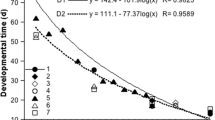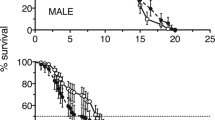Abstract
Individual copepodids from nature of the lipidstoring, monocyclic, diapausing Calanus glacialis, and from nature and laboratory culture of the non-storing, polycyclic Eurytemora herdmani (both collected new Halifax, Nova Scotia in 1987 and 1988) were reared in excess food at ca. 3 and 10 °C. Soon after molts, prosome lengths and weights [total dry wt (TW) of E. herdmani; structural wt (SW) and estimated oil-sac wt (OSW) of C. glacialis] were measured. Stage durations were close to published temperature-dependent predictions; C. glacialis (almost all females) did not enter resting stages. Growth of body length was linear and of body weight (TW or SW) was exponential, with no sexual difference in E. herdmani. There were mixed effects of sizes on stage durations of individuals: weakly positive at 3 °C (but not significant at ca. 10°C) for length and SW of C. glacialis and generally weakly negative for E. herdmani, except for TW at 10 °C. Body condition (residuals of log SW vs log length) of C. glacialis at ca. 10°C, unlike length or SW, was negatively related to stage duration. There was no relationship between length-corrected SW and OSW in C. glacialis. The various results appear to suggest that health was more important than allometric constraints on growth rates of individuals. However, copepods reared at temperatures very different from those previously experienced may show long-term adjustments of size, whereas development rates respond immediately. If so, only the weakly positive effects on stage durations of length of C. glacialis at ca. 3 °C and of TW of E. herdmani at ca. 10 °C may illustrate expectations under stable temperatures and adequate food in nature.
Similar content being viewed by others
Literature cited
Conover, R. J. (1988). Comparative life histories in the genera Calanus and Neocalanus in high latitudes of the northern hemisphere. Hydrobiologia 167/168: 127–142
Corkett, C. J. (1984). Observations on development in copepods. Studies on Copepoda II. Proc. 1st int. Conf. Copepoda, Amsterdam, 1981. Crustaceana (Suppl. 7): 150–153
Corkett, C. J., McLaren, I. A. (1970). Relationships between development rate of eggs and older stages of copepods. J. mar. biol. Ass. U.K. 50: 161–168
Corkett, C. J., McLaren, I. A., Sevigny, J.-M. (1986). The rearing of the marine calanoid copepods C. finmarchicus (Gunnerus), C. glacialis Jaschnov and C. hyperboreus Krøyer with comment on the equiproportional rule. Syllogeus (Nat. Mus. Can.) 58: 539–546
Davis, C. S. (1987). Components of the zooplankton production cycle in the temperate ocean. J. mar. Res. 45: 947–983
Dawirs, R. R. (1984). Influence of starvation on larval development of Carcinus maenas L. (Decapoda: Portunidae). J. exp. mar. Biol. Ecol. 80: 47–66
Diel, S., Klein Breteler, W. C. M. (1986). Growth and development of Calanus spp. (Copepoda) during spring phytoplankton succession in the North Sea. Mar. Biol. 91: 85–92
Escribano, R., McLaren, I.A. (1992). Influence of food and temperature on lengths and weights of two marine copepods. J. exp. mar. Biol. Ecol. 159: 77–88
Frost, B. W. (1980). The inadequacy of body size as an indicator of copepod niches in the zooplankion. In: Kerfoot, W. C. (ed.) Evolution and ecology of zooplankton communities. University Press of New England, Hanover, New Humpshire, p. 742–753
Harris, J. R. W. (1983). The development and growth of Calanus copepodites. Limnol. Oceanogr. 28: 142–147
Hart, R. C. (1990). Copepod post-embryonic durations: pattern, conformity, and predictability. The realities of isochronal and equiproportional development, and trends in the copepodidnaupliar duration ratio. Hydrobiologia 206: 175–206
Katona, S. K. (1970). Growth characteristics of the copepods Eurytemora affinis and E. herdmani in laboratory cultures. Helgoländer wiss. Meeresunters. 20: 373–384
Klein Breteler, W. C. M., Gonzalez, S. R. (1988). Influence of temperature and food concentration on body size, weight and lipid concentration of two calanoid copepod species. Hydrobiologia 167/168: 201–210
Lock, A. R., McLaren, I. A., (1970). Effects of varying and constant temperatures on size of a marine copepod. Limnol. Oceanogr. 15: 638–640
Longhurst, A. R. (1986). Instar increments in copepod growth. Can. J. Fish. aquat. Sciences 43: 1671–1674
Lopez, M. D. G. (1991). Molting and mortality depend on age and stage in naupliar Calanus pacificus: implications for development time of field cohorts. Mar. Ecol. Prog. Ser. 75: 79–89
Marcus, N. M., Alatalo, P. (1989). Conditions for rearing Calanus finmarchicus (Gunnerus, 1770) (Copepoda, Calanoida) through multiple generations in the laboratory. Crustaceana 77: 101–103
McLaren, I. A. (1978). Generation lengths of some temperate marine copepods: estimation, prediction, and implications. J. Fish. Res. Bd Can. 35: 1330–1342
McLaren, I. A. (1986). Is “structural” growth of Calanus potentially exponential? Limnol. Oceanogr. 31: 1342–1346
McLaren, I. A., Corkett, C. J. (1981). Temperature-dependent growth and production by a marine copepod. Can. J. Fish. aquat. Sciences 38: 77–83
McLaren, I. A., Laberge, E., Corkett, C. J., Sévigny, J.-M. (1989a). Life cycles of four species of Pseudocalanus in Nova Scotia. Can. J. Zool. 67: 552–558.
McLaren, I. A., Sévigny, J.-M., Corkett, C. J. (1989b). Temperature-dependent development in Pseudocalanus species. Can. J. Zool. 67: 559–564
McLaren, I. A., Tremblay, M. J., Corkett, C. J., Roff, J. C. (1989c). Copepod production on the Scotian Shelf based on life-history analyses and laboratory rearings. Can. J. Fish. aquat. Sciences 46: 560–583
Middlebrook, K., Roff, J. C. (1986). Comparison of methods for estimating annual productivity of the copepods Acartia hudsonica and Eurytemora herdmani in Passamaquoddy Bay, New Brunswick. Can. J. Fish. aquat. Sciences 43: 656–664
Miller, C. B., Johnson, J. K., Heinle, D. R. (1977). Growth rules in the marine copepod genus Acartia. Limnol. Oceanogr. 22: 326–335
Peterson, W. T. (1986). Development, growth and survivorship of the copepod Calanus marshallae in the laboratory. Mar. Ecol. Prog. Ser. 29: 61–72
Peterson, W. T., Painting, S. J. (1990). Development rates of the copepods Calanus australis and Calanoides carinatus in the laboratory, with discussion of methods used for calculation of development times. J. Plankton Res. 12: 283–293
Tester, P. A. (1985). Effects of parental acclimation temperature and egg-incubation temperature on egg-hatching time in Acartia tonsa (Copepoda: Calanoida). Mar. Biol. 89: 45–53
Uye, S. (1988). Temperature-dependent development and growth of Calanus sinicus (Copepoda: Calanoida) in the laboratory. Hydrobiologia 167/168: 285–293
Vidal, J. (1980). Physioecology of zooplankton. I. Effects of phytoplankton concentration, temperature, and body size on the growth rate of Calanus pacificus and Pseudocalanus sp. Mar. Biol. 56: 111–134
Vidal, J., Smith, S. L. (1986). Biomass, growth, and development of populations of herbivorous zooplankton in the southeastern Bering Sea during spring. Deep-Sea Res. 33: 523–556
Wilkinson, L. (1987). SYSTAT: the system for statistics. SYSTAT, Inc., Evanston, Illinois
Author information
Authors and Affiliations
Additional information
Communicated by R. Thompson, St. John's
Rights and permissions
About this article
Cite this article
Eseribano, R., McLaren, I.A. Testing hypotheses of exponential growth and size-dependent molting rate in two copepod species. Marine Biology 114, 31–39 (1992). https://doi.org/10.1007/BF00350853
Accepted:
Issue Date:
DOI: https://doi.org/10.1007/BF00350853




